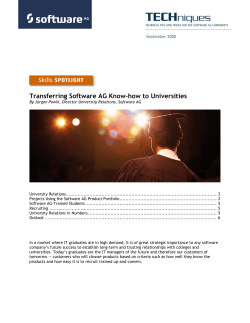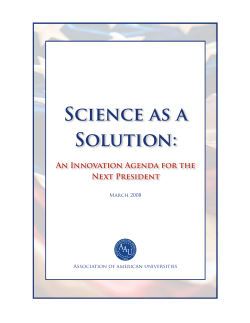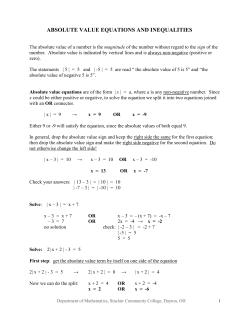
How To Make Science an Engine of Growth:
How To Make Science an Engine of Growth: Getting Incentives Right is Important Paula Stephan Georgia State University NBER Presentation Based on book Considerable Evidence that Research Contributes to Economic Growth • Two Examples should suffice – Life expectancy: increased by 14 years since 1940 • Research which led to the development of antibiotics and treatments for cardiovascular disease has played a role; • Research which leads to changes in behavior—anti- smoking campaign —also plays a role – Advances in Information Technology have contributed to economic growth. Advances come from research that has led to new products, such as • Integrated Circuit • World Wide Web • Modern capacity hard drives Public Sector Plays Important Role • Much of research that (eventually) contributes to economic growth takes place in public sector and is supported by public funds • This research is not sufficient for growth: Industry plays an absolutely crucial role • Given important role that public research plays and long lags between research and economic growth, policies that affect public research today will have an impact for many years to come Crucial to Get More Out of Public R&D Budgets: Focus Today • Always important—but more important in times of austerity • Book explores how public research organizations and scientists respond to incentives • It’s a good news/bad news story – Get incentives right, and one can enhance productivity – Get incentives wrong, and there are severe consequences for productivity Many Examples Come from United States • System I know the best – Served on National Science Foundation Advisory Boards – Served on Advisory Board for a large institute at NIH (National Institutes of Health) – Serve on Board on Higher Education, National Research Council • U.S. system that is often held up as an example for other countries Four Areas of Focus • • • • Incentives: Incentives: Incentives: Incentives: research? risk aversion hiring and rewards inefficient use of human resources investing in the right mix of One Minute Lesson on U.S. System • Universities receive approximately $55 billion for R&D annually • 60% comes from the Federal Government • Over half of that is National Institutes of Health funding (NIH) • National Science Foundation (NSF) is about 10%; Department of Defense, Department of Energy also support university research • 6 out of 10 federal dollars distributed by peer review to university researchers in United States Support for academic R&D, by sector: 1953–2008 100.00% 50000 90.00% 80.00% 40000 60.00% 30000 50.00% 40.00% 20000 30.00% 20.00% 10000 10.00% 0 0.00% Federal Government State and Local Government Industry Institutional Funds All Other Sources Federal Government State and Local Government Industry Institutional Funds All Other Sources Percent Distribution Constant 2008 Dollars (Millions) 70.00% Peer Review • Seen as gold standard for distributing funding – Encourages freedom of intellectual inquiry – Promotes sharing of information – Provides incentives to remain productivity throughout one’s career – Open in sense that last year’s “loser” can be this year’s winner – Encourages entrepreneurship—getting money from a venture capitalist is much like getting money from a federal agency—one has to “sell” one’s research • Majority of grants are for 3-5 years • Faculty salary is part of the grant; also funds for graduate students, postdocs and equipment and materials and “indirect recovery.” • Faculty in “soft money” positions must support themselves entirely off grants All is Not Well with U.S. Peer Review • Risk Aversion: Scientists avoid risk by submitting proposals they see as “sure bets” • Why? – In order to keep one’s lab functioning one must have external support; university only supports lab for 3 years – Need for faculty to obtain grants to support their salary— especially important for faculty on soft money—perhaps 35% of NIH investigators –no funding, no job! – Low probability of success (17 to 20 percent at NIH)— reviewers prefer proposals with convincing preliminary data: “no crystal, no grant.” • Roger Kornberg: To quote the Nobel laureate Roger Kornberg, “If the work that you propose to do isn’t virtually certain of success, then it won’t be funded.” Concern for Economic Growth • Pretty clear that if most scientists are risk averse little chance that transformative research will occur, leading to significant returns from investments in research and development. • Incremental research yields results, but in order to realize substantial gains need more people doing transformative work. Hiring and Rewards • United States known for strong research universities • Having resources to attract and reward highly productive scientists is important component of this • Creates wide salary differentials in departments and between universities Salary Differentials • Private-vs. public – Only one public institution (UCLA) in top 20 salary list. Pays over $40,000 less than top-paying Harvard • Differences across and within Institutions – Differences within rank across institutions—faculty of same rank can earn three times as much as faculty of that rank at another institution – Wide differences within departments for same rank— in some instances faculty can earn twice as much as colleagues with same rank. Inequality on the Rise in Academe • Gap between the haves and have-nots is not as big as that in US society at large, but within academe inequality has grown at almost three times the rate of growth of inequality in the larger society. • Inequality contributes to research productivity by attracting and rewarding productive people • But where does one draw the line? Two Concerns with Inequality • The divide between rich and poor universities threatens to make more and more universities non-competitive when it comes to hiring and retaining top researchers. U.S. risks losing some of our great research universities—many of which are “public” • Substantial income inequality within a university—and a department—threatens fabric of the university – Strong universities are built by faculty working together to build new programmes and curricula and by providing excellence in the classroom. – An over-emphasis on research productivity when it comes to rewards, with associated increase in income inequality, can significantly dull incentives to contribute to other objectives of the university. – Also reduces incentive for scientists to work together on research projects—yet we know that collaboration is extremely important in research. Human Resources • University labs in United States are staffed by graduate students and postdocs • Many pluses – Fresh ideas – Flexible – Temporary – Cheap Pyramid System (Scheme?) • Works only if funding—and thus research positions-grows • It is increasingly difficult for young researchers to find independent research positions in academe or government. Increasingly difficult in industry as well • Results in large group of disenchanted young researchers; socially inefficient Biological Sciences: 5-6 Year Cohort 60.00% 50.00% 40.00% 30.00% 20.00% 10.00% 0.00% 1973 1977 1981 1985 1989 1993 1997 2001 2003 2006 Tenure Track Non Tenure Track Post Doc Industry Government Out of Labor Force and Part Time Efficient Mix of What is Funded? Focus on Biomedical Sciences • Two-thirds • Why? – Extremely organized disease-focused lobby in United States for biomedical research – Public is supportive – Congress is “old” Focus on Biomedical Sciences Led to a Building Boom at U.S. Universities Incentives Played a Big Role • Rules allow interest on debt to be included in calculating indirect rate • Universities sought to fill new buildings with many researchers on soft money—no risk to universities in terms of salary commitment Consequences • Universities may have trouble servicing the bonds given that NIH budget is not growing • Unless they default, “others” will pay – Students – Faculty – Other disciplines Inefficient? • • • • Is putting all these funds into the biomedical sciences efficient? May be time to readjust the U.S. federal R&D portfolio Biomedical research has had a great run But unclear that marginal product of another dollar spent in biomedical research is as high as it once was. May be time to reallocate! – Diminishing returns are likely present--suggested by slowed rate at which new drugs are being brought to market and less than stellar increase in U.S. publications associated with the doubling of NIH budget. – Many of breakthroughs that have contributed to better health outcomes have come from other fields of science—the laser and the MRI, for example. – Funds for the physical sciences in the United States (in terms of the percentage of federal research funding) are close to a 35-year low. Summing Up • US system has produced great science which in turn has contributed to economic growth • Much of this can be attributed to opportunities that have been available for researchers in the US, and the incentives underlying these opportunities. • But incentives can have a downside as well as an upside. • There are lessons that any country or group of countries should attend to when they think of emulating the US system. Questions/Comments • pstephan@gsu.edu
© Copyright 2025





















